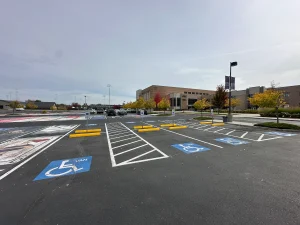How Poor Water Drainage Damages Your Asphalt and Leads to Costly Repairs
Water might seem harmless, but for asphalt surfaces, especially parking lots and roadways, it’s one of the most destructive forces at play. Poor drainage in asphalt can cause rapid deterioration, leading to cracks, potholes, and costly repairs if left unchecked. Whether you’re a property manager, business owner, or facilities supervisor, understanding how drainage affects your pavement can help you save money and extend the life of your asphalt investment.
Why Drainage Is Critical to Asphalt Longevity
Asphalt is a durable, flexible material designed to withstand heavy loads and weather conditions. However, it’s not waterproof. When water is allowed to pool or seep beneath the surface due to poor drainage, it begins to break down the pavement from the inside out.
- Water weakens the base layers beneath the asphalt, which are essential for structural support.
- Freezing and thawing cycles cause the water to expand and contract, creating cracks and pushing up the pavement.
- Over time, the pavement becomes unstable, uneven, and unsafe.
Signs Your Asphalt Has Drainage Problems
Knowing what to look for can help you catch drainage issues early, before they lead to major damage. Common warning signs include:
- Standing water after rainstorms
- Cracking patterns in areas where water tends to collect
- Potholes forming in low-lying spots
- Surface depressions or warping
These problems typically indicate that water is not draining properly and that the base layers may be compromised.
The Cost of Ignoring Drainage Issues
One of the most expensive mistakes property owners make is putting off repairs caused by drainage. What starts as a small puddle can turn into a large section of failed pavement requiring full removal and replacement.
Here’s how drainage-related damage escalates:
- Cracks allow water to penetrate deeper.
- The base material erodes and shifts.
- Potholes form and worsen with traffic.
- Entire sections of asphalt sink or collapse.
Neglecting drainage problems can multiply repair costs and even affect ADA compliance, customer safety, and curb appeal.
How to Prevent Water Damage to Your Asphalt
Fortunately, there are several ways to protect your asphalt from drainage-related issues:
- Proper Grading and Slope Design
Ensure your parking lot is built with a slope that directs water away from the pavement toward storm drains or swales. - Regular Maintenance
Schedule periodic inspections, especially after storms. Crack sealing and sealcoating can help prevent water intrusion. - Drainage System Upgrades
Install trench drains, catch basins, or French drains in problem areas. - Professional Paving Services
Work with a qualified asphalt contractor who understands local conditions and how to design for long-term drainage performance.
Conclusion: Don’t Let Water Destroy Your Asphalt
Water is one of the biggest threats to the lifespan of your asphalt parking lot or roadway. Poor drainage can cause damage that’s not only expensive to fix, but also dangerous for vehicles and pedestrians. By identifying problem areas early and investing in proper drainage design and maintenance, you can protect your investment, extend the life of your pavement, and avoid unnecessary repair costs.


